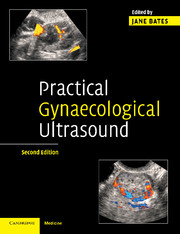Book contents
- Frontmatter
- Contents
- List of contributors
- Preface
- 1 Equipment selection and instrumentation
- 2 Practical equipment operation and technique
- 3 Anatomy, physiology and ultrasound appearances
- 4 Pathology of the uterus, cervix and vagina
- 5 Pathology of the ovaries, fallopian tubes and adnexae
- 6 Ultrasound in the acute pelvis
- 7 Ultrasound and fertility
- 8 Paediatric gynaecological ultrasound
- 9 Clinical management of patients: the gynaecologist's perspective
- Index
- References
6 - Ultrasound in the acute pelvis
Published online by Cambridge University Press: 04 March 2010
- Frontmatter
- Contents
- List of contributors
- Preface
- 1 Equipment selection and instrumentation
- 2 Practical equipment operation and technique
- 3 Anatomy, physiology and ultrasound appearances
- 4 Pathology of the uterus, cervix and vagina
- 5 Pathology of the ovaries, fallopian tubes and adnexae
- 6 Ultrasound in the acute pelvis
- 7 Ultrasound and fertility
- 8 Paediatric gynaecological ultrasound
- 9 Clinical management of patients: the gynaecologist's perspective
- Index
- References
Summary
Introduction
Ultrasound is the first examination of choice in patients with acute pelvic pain, regardless of age, presentation or gender, and a more common request in females than males. Pelvic pain represents 10–15% of all urgent ultrasound examinations performed in a district general hospital (local audit) and results from a large variety of underlying causes, many of which may be gynaecological. The causes of pain vary and will depend upon the location, organ involved and underlying pathology such as infection, haemorrhage, infarct or ectopic pregnancy (EP).
The examination of choice in these circumstances is a combination of transabdominal (TA) and transvaginal (TV) ultrasound except in young girls and those with an intact hymen. The use of high-frequency vaginal probes and the proximity of the probe to the pelvic organs allow clear visualisation of the pelvic organs. The ability of the vaginal probe to touch the pelvic organs allows the sonographer to test for pain and detect the mobility of these organs, which are two important and useful signs in evaluating the cause of pelvic pain.
TA ultrasound is advantageous because of its ability to visualise large pelvic masses, detect the presence of ascites and examine other structures such as the kidneys and the other upper abdominal organs, which may be associated with the pain. However, TA ultrasound may be technically difficult in acute pelvic pain due to the presence of ileus, abdominal wall tenderness/rigidity and the lack of filling of the urinary bladder (which is frequently associated in particular with pelvic inflammation).
- Type
- Chapter
- Information
- Practical Gynaecological Ultrasound , pp. 103 - 119Publisher: Cambridge University PressPrint publication year: 2006



